|
HISTORIC OLD TOWN SAN DIEGO CULTURAL DIVERSITY WALKING TOUR
This self-guided walking tour offers a rich guide to the diverse groups of people and cultures that form Old Town San Diego's history as experienced through its buildings, streets, and open spaces. Old Town's architecture is not only varied in appearance and materials; it also provides cultural insights into the lives of the different peoples who once called Old Town home, and the cultural influences that make this place unique.
Many of the settlers and soldiers who originally colonized the area in 1769 were of mixed ancestry. Old Town was a veritable polyglot of native Kumeyaay, Spaniards, Mexicans, Portuguese, Peruvians, African Americans, English, French, Germans, Irish, Chinese, Filipinos, Hawaiian Islanders, and more. As Old Town has developed over time some structures have been lost to growth and natural or other disasters. This tour features only original buildings that remain standing and those meticulously reconstructed to appear as they did when new, all originating from the early 1800s through the 1930s.
As you make your way to each location, imagine the mix of people passing you on the street, and their wealth of customs, and characteristics. We can still see, celebrate, and learn from all these fascinating influences today.
1. The Whaley House
1857, renovated by the County of San Diego in 1958; restored by SOHO to the 1868-1872 period from 2001 to the present
2476 San Diego Avenue
Thomas Whaley of Brooklyn, New York, designed and built this fine two-story house for his family after moving to California for the Gold Rush. The oldest brick home in San Diego, this rare Greek Revival residence showcases one of the new types of architecture that Americans brought from the east. Over time, the Whaleys shared their private home with other income-producing functions, such as a general store, town courthouse, and San Diego's first public theater. Thomas' wife Anna was French and her immigrant mother lived with the family, so the children naturally learned French. As we've already seen, couples from different cultures inter-married and became bi- or even trilingual. Businessmen such as Thomas Whaley found it important to speak the languages of their customers. In addition, in the mid-1870s, the Whaley family employed Ts Yow, a young Chinese immigrant, as a cook and for property maintenance.
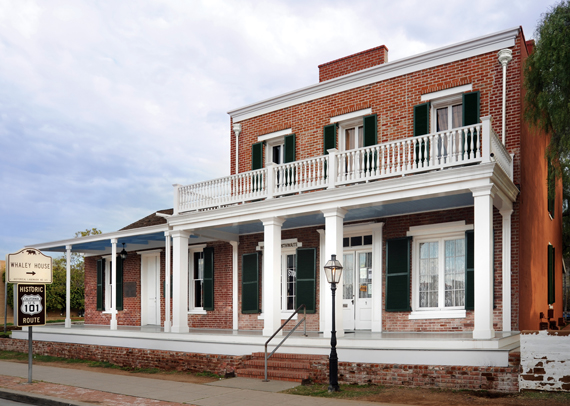 Photo by Sandé Lollis Photo by Sandé Lollis
OPEN IN GOOGLE MAPS
2. Mormon Battalion Historic Site
1847, new Visitors Center dedicated in 2010
2510 Juan Street
In 1846, during the Mexican-American War, the 500-member Mormon Battalion of the Church of Jesus Christ of Latter-day Saints, walked from the Council Bluffs area of Iowa to San Diego to join the U.S. forces. This year-long march covered nearly 2,000 miles; along the way, the soldiers improved trails to the west. These men never engaged in battle, but many lost their lives during the long and strenuous journey. The visitors center was added in the 1960s, and enhanced with an interactive museum exhibit in 2014.
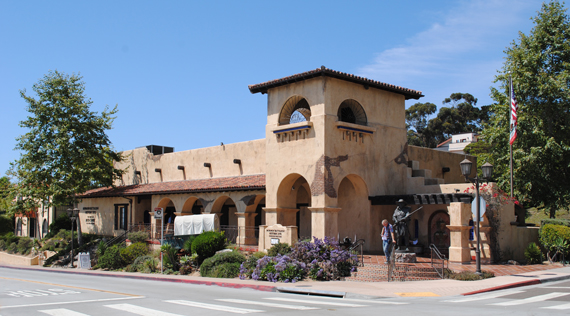 Photo by Marlena Krcelich Photo by Marlena Krcelich
OPEN IN GOOGLE MAPS
3. Ruiz-Carrillo Adobe
c. 1810-1817, restored in 1931
4136 Wallace Street
This adobe was home to Francisco María Ruiz, a Mexican-born presidio comandante, and, the site of one of California's most famous love stories. Captain Ruiz built this house, c. 1810-1817, next to his 1808 pear orchard. He later gave the house and orchard to three of his godchildren, whose father was Joaquín Carrillo, a close relative and fellow soldier. In April 1829, Joaquín's daughter Josefa Carrillo scandalously left this house for Chile, eloping with Henry Delano Fitch, a Yankee trader and sea captain who may have been San Diego's first American settler. The couple later settled in San Diego. Their tale of bicultural love remains one of old California's most romantic stories. The home changed hands several times, deteriorating gradually. In 1932, San Diego merchant, preservationist, and philanthropist George Marston and associates renovated the adobe and grounds, and deeded them to the City of San Diego for the Presidio Golf Course, which is still in use.
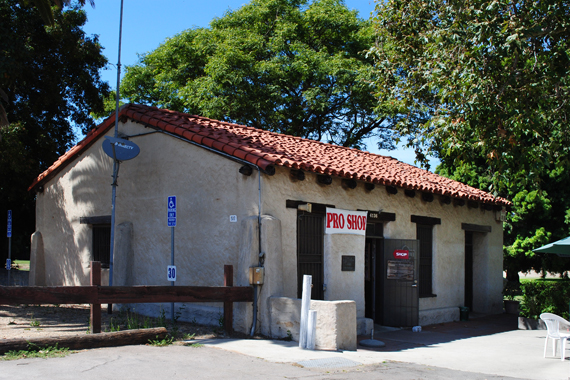 Photo by Marlena Krcelich Photo by Marlena Krcelich
OPEN IN GOOGLE MAPS
4. Robinson Rose House
1853, reconstructed in 1989
4098 Mason Street
James Robinson came to San Diego from Texas in 1850. He built this home for his second wife and their son. Familiar with American and especially Mexican land law, Robinson developed a successful law practice and pursued other business interests, including efforts to establish a railroad. He had a long career in public office, including as city attorney. This structure is a two-story adobe in the Monterey style, developed in Northern California, with the characteristic second-story wooden balcony or veranda. Upon Robinson's death, German immigrant Louis Rose, Old Town's first Jewish settler and an acquaintance of the prominent Estudillo family, bought the building. Rose opened a saloon on the first floor, and enjoyed viewing plaza events from the balcony. He served on the town's first grand jury and later was a city trustee. Like Masons' co-founder Robinson before him, Rose was a charter member of San Diego's first Masonic Lodge and both men opened the house to the group's meetings.
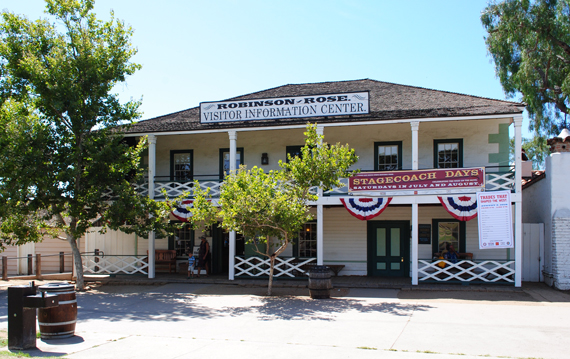 Photo by Marlena Krcelich Photo by Marlena Krcelich
OPEN IN GOOGLE MAPS
5. McCoy House
1869, reconstructed in 2000
4002 Wallace Street
An Irish-born immigrant, James McCoy came to San Diego in 1849 after serving in the U.S. Army, and built this house in 1869 for himself and his wife Winnifred. The Greek Revival, wood-framed home with a columned front porch was a popular style among wealthy 19th-century Americans. McCoy served as county assessor in 1859, was city sheriff for ten years beginning in 1861, and was elected a state senator in 1871. His family hired Modesto Maria Alto Campbell, the wife of McCoy's deputy, Nicholas Campbell, as their cook. Maria's mother was a Mission Indian and her marriage to Nicholas shows the diversification and intermingling of different cultures throughout Old Town through the late 1800s.
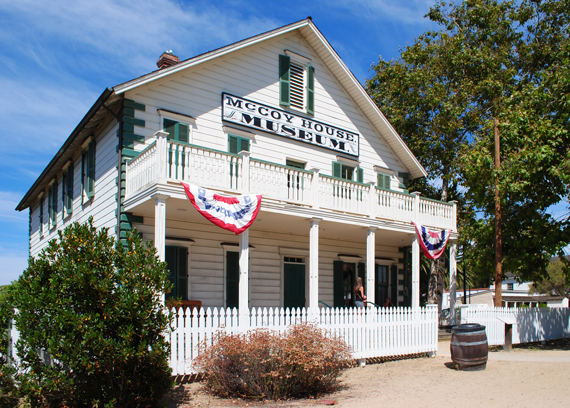 Photo by Marlena Krcelich Photo by Marlena Krcelich
OPEN IN GOOGLE MAPS
6. La Casa de Machado y Wrightington
c. 1830, reconstructed in 1985
2769 San Diego Avenue
This c. 1830 adobe dwelling is the first one José Manuel Machado built for one of his betrothed daughters. It was for Juana Machado and her first husband, who died in 1835. She then married Massachusetts native Thomas Wrightington, who arrived in San Diego in 1833 on the ship Ayacucho. Thomas died in 1853, but Juana remained in the house until the late 1890s. She became known in the Old Town pueblo as a folk healer and surrogate mother to the less fortunate. She spoke Spanish, English, and the local Kumeyaay dialect, having lived in San Diego under the rule of Spain, Mexico, and the United States. Her generosity earned her the nickname "the Florence Nightingale of Old Town."
 Photo by Marlena Krcelich Photo by Marlena Krcelich
OPEN IN GOOGLE MAPS
|
|








